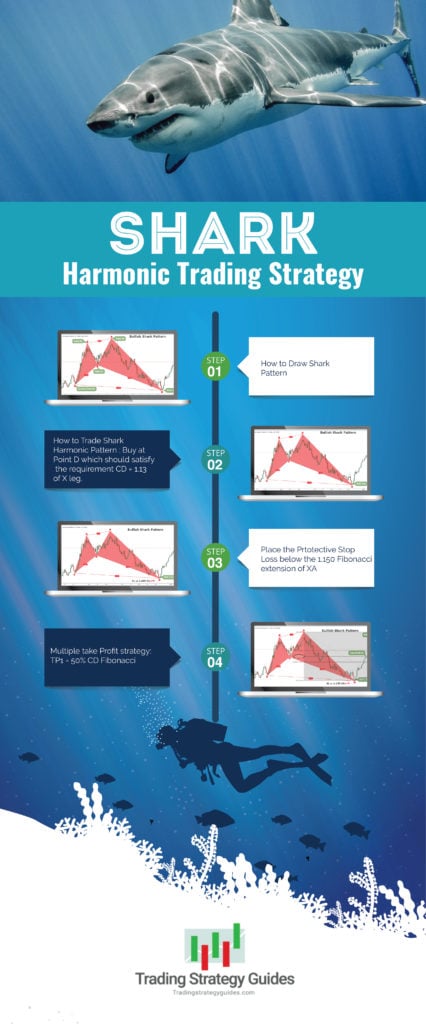Master The Shark Harmonic Pattern: Take A Bite Out Of Markets

Summary:
The Shark harmonic pattern is a technical trading pattern utilized by traders to identify potential reversals in financial markets. It is characterized by distinct price movements that form specific geometric shapes, indicating potential areas of trend reversal.
To draw the Shark pattern on a chart, traders first identify the initial impulse leg (X to A), followed by a corrective move (A to B), a secondary impulse leg (B to C), and a final corrective move (C to D). The completion point of the pattern (point D) provides a potential entry opportunity for traders seeking to capitalize on anticipated trend reversals.
Drawing the Shark pattern on a chart requires careful attention to price movements and adherence to Fibonacci ratios, facilitating accurate identification and interpretation of this harmonic pattern [1].
Retail traders are always going to be small fish in a shark-infested ocean. There are more powerful traders in the market. If you want to learn how to swim with the sharks, get ready to dive into our detailed Shark Harmonic trading strategy.
This is the best Shark Harmonic Pattern Trading Strategy you can find online.
Our team at Trading Strategy Guides is building up the most comprehensive content about Harmonic trading.
We highly recommend that you start by reading the introduction of the harmonic patterns here, Harmonic Pattern Trading Strategy Guide.
It will give you a better understanding of how to trade the Shark Pattern.
The Shark pattern is a relatively new harmonic pattern. In 2011, the pattern was discovered by Scott Carney, but it has the same features as many harmonic patterns. This is because it follows certain Fibonacci ratios for its structure to be validated.
The Harmonic Shark Pattern has some similarities with the Crab harmonic pattern. This is because both of these harmonic patterns shave an overextended point C.
The bullish Shark pattern can be traded on all time frames. But we recommend to only trade the harmonic chart pattern from the 1-hour time-frame and above.
Now let’s learn the best Shark Harmonic Pattern Trading Strategy
Table of Contents
Introduction: Shark Pattern Trading Strategy
Before we explore deeper into the Shark pattern harmonic trading strategy, let’s look at the indicators needed to successfully trade this strategy.
The advancement in trading technology has made identifying the Shark chart pattern easier for trade
Many platforms have built-in automated indicators that draw the Shark pattern. This feature helps traders visualize the pattern better. At the same time, make sure that it follows the Fibonacci ratios, as per the rules.
You can find the Harmonic Pattern Indicator on most popular Forex trading platforms (TradingView and MT4) in the indicator section. Here is another strategy called Time-Based Trading Strategy.
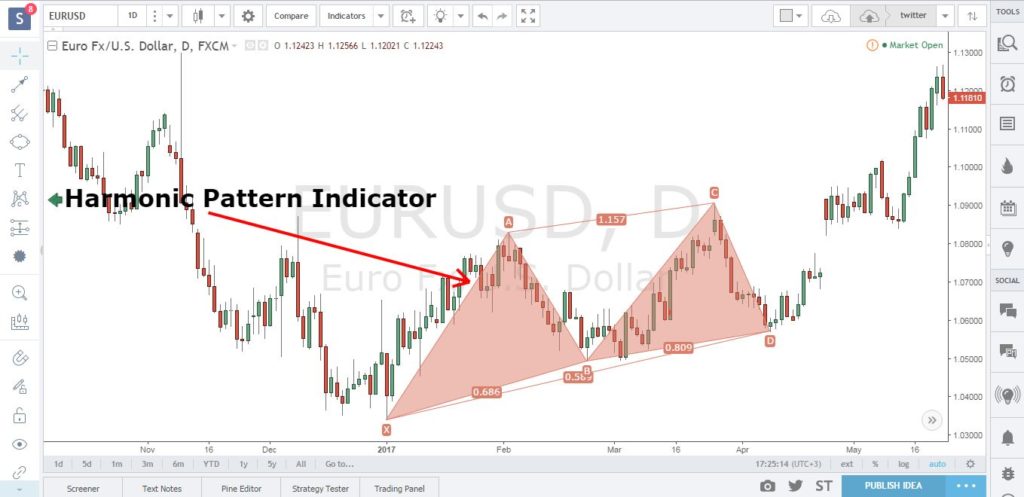
Now, let’s move forward and see how to trade the Shark harmonic pattern.
How to Trade the Shark Harmonic Pattern
The Shark trading strategy, like any other harmonic pattern, is a five-leg reversal pattern. It follows specific Fibonacci ratios.
The harmonic Shark pattern differentiates itself from the other harmonic patterns by its five points setup being labeled as O, X, A, B, C. Also, the termination point of leg B ends above wave X. It extends to a minimum of 1.13 and a maximum of 1.618 Fibonacci ratios.
A proper Shark pattern needs to fulfill the following three Fibonacci rules:
- AB= retrace between 1.13 – 1.618 Fibonacci Extension of XA leg;
- BC= extends to 113% Fibonacci extension of 0X leg;
- CD= Poses a target of 50% Fibonacci Retracement of BC leg
Note* the Fibonacci retracement and ratios are at the core of harmonic trading. Make sure the above rules are satisfied before you trade the Shark harmonic pattern.
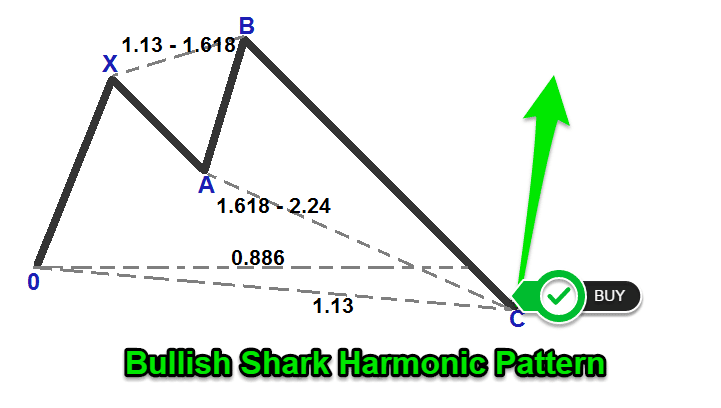
The Shark pattern is an emerging 5-O pattern as the Harmonic Shark pattern is within the 5-O pattern structure.
The structure of the Shark pattern means that, unlike the other harmonic patterns, all trades are taken based on point C. While the point D is actually used as a pre-defined profit target.
Ideally, the completion point of the CD swing-leg terminates at 50% Fibonacci retracement of BC leg. It must also satisfy the AB=CD condition.
This is the most common way the Harmonic Shark pattern is traded by trying to capture the last move of a complex pattern entering at C. It also has a protective stop loss above/below the 2.24 of AB retracement and targeting the 50% retracement of the BC swing-leg.
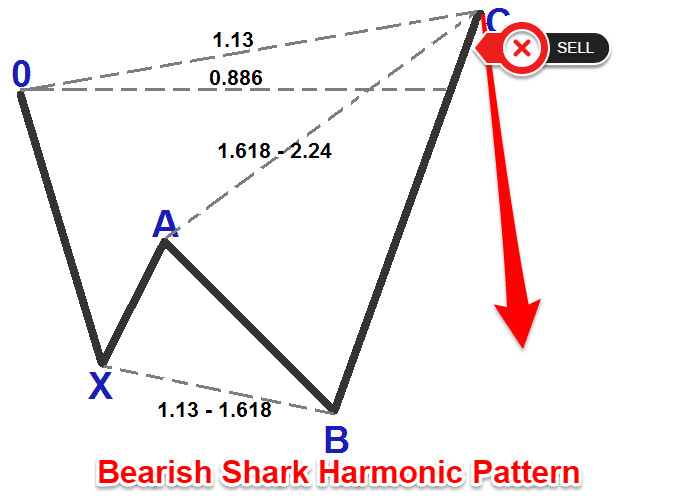
Let’s take one step forward and see how you can make money applying the Shark trading rules.
Shark Pattern Trading Strategy
The way we’re proposing to trade this pattern is to enter at the open of the next candle after our Harmonic indicator has spotted the Shark pattern.
So, to clear up the confusion, as soon as the C-leg is established, we enter the market with a protective stop loss at the 2.618 extension of AB swing-leg.
Step #1 How to Draw Shark Harmonic Pattern
To learn how to draw the Shark pattern simply follow this step by step guide – see figure below for a better understanding of the process:
- First, click on the harmonic pattern indicator which can be located on the right-hand side toolbar of the TradingView platform.
- Identify on the chart the starting point 0, which can be any swing high or low point on the chart.
- Once you’ve located your first swing high/low point you simply have to follow the market swing wave movements.
You need to have 4 points or 4 swings high/low points that bind together and form the harmonic crab pattern strategy. Every swing leg must be validated and abide by the Shark pattern forex Fibonacci ratios presented above.
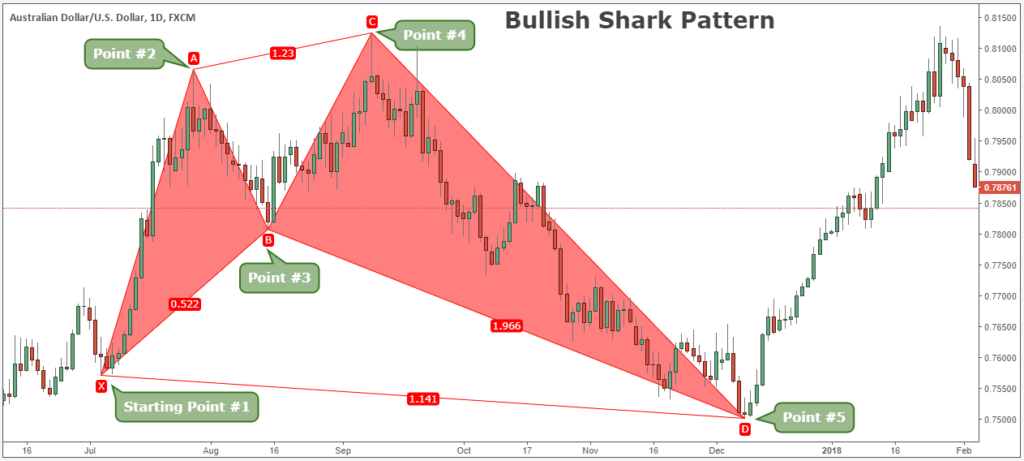
Now, we’re going to lay down the bearish Shark pattern rules.
See below…
Note* for the purpose of this article we’re going to use the case for a bullish Shark harmonic.
Step #2: How to Trade Shark Harmonic Pattern: Buy at Point D which should satisfy the requirement CD = 1.13 of OX leg.
The D to X retracement can be anywhere between 0.886 – 1.13. But we prefer taking trades using the ideal 1.13 extension.
The shark pattern has some common characteristics with the Crab pattern because the wave D is a sharp price movement in both harmonic patterns.
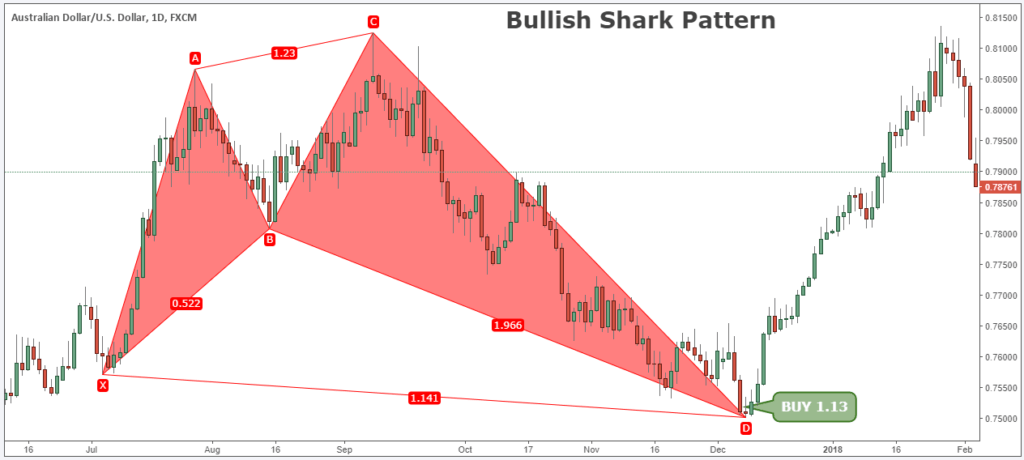
The next important thing we need to establish is where to place our protective stop loss.
See below…
Step #3: Place the Protective Stop Loss below the 1.150 Fibonacci extension of XA.
The initial protective stop loss should be at 1.150 Fibonacci extension of XA and once the market starts moving toward our first take profit price it should be moved at the completion of D leg.
That’s the logical place to hide your stop loss because any break below will automatically invalidate the Fibonacci requirements for a Shark pattern.

The biggest advantage of trading the Shark pattern is that it requires the use of a very tight stop loss. This is good news as we always want to minimize losses and maximize profits.
The next logical thing we need to establish for the Shark trading strategy is where to take profits.
See below…
Step #4: Multiple Take Profit Strategy: TP1 = 50% CD Fibonacci retracement; TP2 = C swing high.
Because of the complexity and the price structure of the Shark pattern we’re going to have two taking profit zones.
The first TP zone is at the 50% Fibonacci retracement CD swing-leg and the 100% retracement for the second TP.
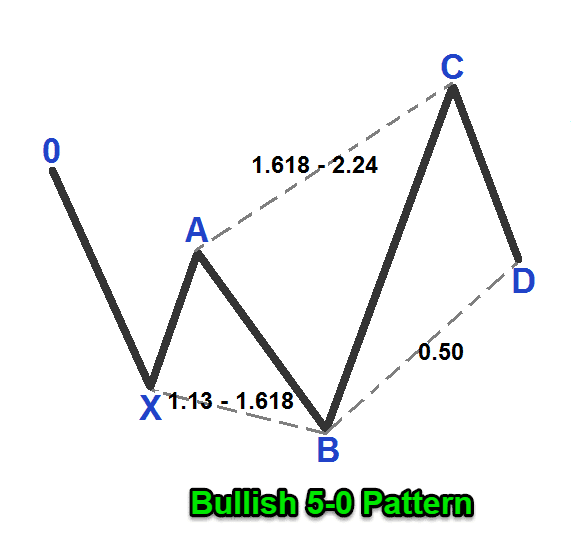
The reason why we use two possible TP zones is because in essence, the Shark pattern leads to the 5-0 pattern (see Figure above) and once we reach the D point it can reverse, however, the Shark pattern can be a reversal pattern in itself and that’s why we’re using as a second target the 100% Fibonacci ratio.
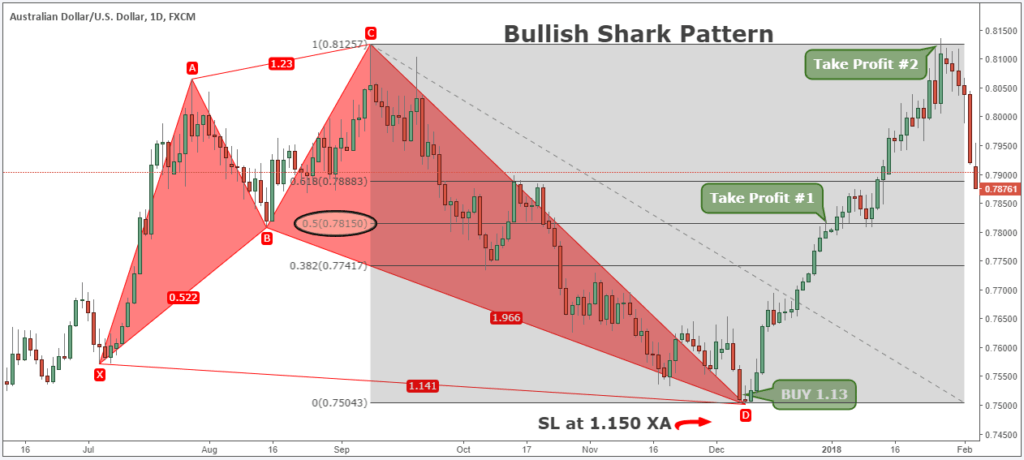
Note** the above was an example of a BUY trade using the Bullish Shark pattern trading strategy. Use the same rules for a SELL trade. In the figure below, you can see an actual SELL trade example using the bearish shark pattern.
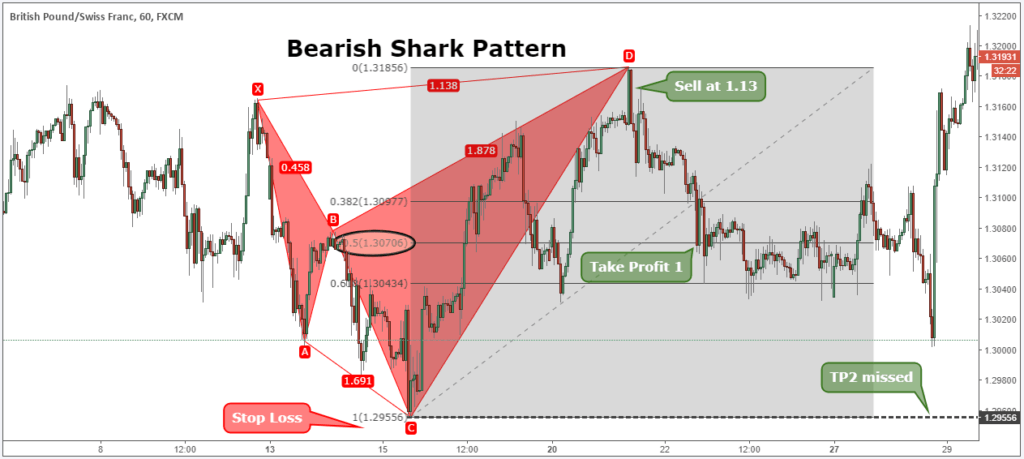
Shark Harmonic Pattern Trading Strategy Video
Conclusion: Harmonic Shark Pattern Trading Strategy
Like any newly discovered pattern we need to be cautious when trading the Harmonic Shark Pattern and only trade the best price structure that fits into all the Fibonacci ratios with deadly precision. You can also read our winning news trading strategy.
The shark harmonic trading strategy works extremely well as a strong counter-trend strategy. You can also learn pretty much fast if the shark harmonic pattern will work or not because it requires immediate price reversal following the chart pattern completion.
Thank you for reading!
Please leave a comment below if you have any questions about the shark trading strategy!
Also, please give this strategy a 5 star if you enjoyed it!
More Harmonic Patterns
- Harmonic Pattern Trading Strategy
- Gartley Harmonic Pattern
- Butterfly Harmonic Pattern
- Crab Harmonic Pattern
- Bat Harmonic Pattern
Shark Harmonic Pattern FAQ’s
How does the Shark pattern work in trending markets versus range-bound markets?
In trending markets, the Shark pattern can be used to identify potential reversal points where price may exhaust its current trend and start a new trend in the opposite direction. Traders may look for Shark patterns to form after a strong impulse move, signaling a possible trend reversal.
In range-bound markets, the Shark pattern can still be traded, but traders should exercise caution as price may exhibit more choppy behavior and less directional movement. It’s essential to consider other factors such as support and resistance levels, market volatility, and overall market sentiment when trading the Shark pattern in range-bound conditions
How does the Shark pattern differ from other harmonic patterns, such as the Cypher and Crab patterns?
While the Shark, Cypher, and Crab patterns are all types of harmonic patterns, they differ in their structure and key Fibonacci ratios.
The main differences include:
* The Shark pattern has a deeper retracement at point B compared to the Cypher and Crab patterns.
* The Crab pattern has a more extended BC leg, typically reaching the 2.24 or 3.618 Fibonacci extension of the AB leg.
* The Cypher pattern has a specific retracement at point C, typically around the 0.382 or 0.618 Fibonacci level of the XA leg, before continuing in the direction of the pattern.
What are the key characteristics of the 5-point reversal structure in the Shark pattern?
The 5-point reversal structure in the Shark pattern consists of five key points labeled X, A, B, C, and D.
They are:
* Point X is the starting point of the pattern and represents the initial impulse leg.
* Points A and B form the initial retracement, with point B typically retracing beyond the 0.886 Fibonacci level of the XA leg.
* Point C marks the extension beyond the XA leg, usually reaching the 1.13 or 1.618 Fibonacci extension of the XA leg.
* Point D is the potential reversal point, typically located near the 0.886 Fibonacci retracement of the XC leg.
What is the most powerful harmonic pattern?
The concept of a “most powerful” harmonic pattern can be subjective and depends on various factors such as market conditions, timeframe, and individual trader preferences.
However, some traders consider the Gartley pattern to be one of the most powerful harmonic patterns due to its clear structure and high probability of success when properly identified and traded. The Gartley pattern often signifies trend reversals and offers favorable risk-reward ratios.
Shark Harmonic Pattern Trading Strategy Free PDF/Info-Graphic Download
Please Share this Shark Harmonic Pattern Trading Strategy Below and keep it for your own personal use! Thanks Traders!
